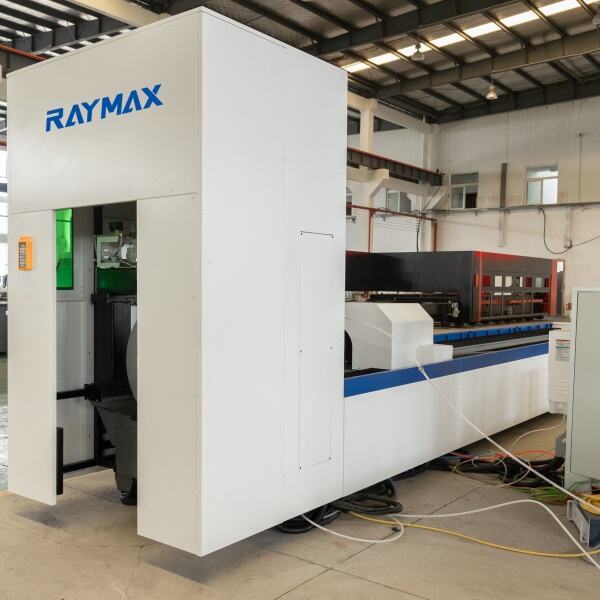บทบาทของระบบทำความเย็นในเครื่องตัดเลเซอร์ไฟเบอร์
การป้องกันไม่ให้เครื่องรับความร้อนเกินในขณะใช้งานกำลังสูง
ระบบทำความเย็นถือเป็นสิ่งสำคัญที่ช่วยควบคุมความร้อนที่เกิดขึ้นจากพื้นที่ตัดในงานตัดด้วยเลเซอร์กำลังสูง ซึ่งอุณหภูมิอาจสูงเกิน 300°C สถาบันเลเซอร์แห่งอเมริกา (Laser Institute of America) ได้ทำการวิจัยและพบว่า การทำความเย็นที่มีประสิทธิภาพสามารถลดโอกาสเกิดข้อผิดพลาดที่เกี่ยวข้องกับความร้อนสูงเกินได้มากถึง 70% สิ่งนี้มีความสำคัญเนื่องจากความร้อนสูงเกินสามารถส่งผลต่อคุณภาพของการตัด และลดประสิทธิภาพในการกลไกการกำจัดเศษวัสดุ ระบบทำความเย็นมักใช้ทั้งน้ำและอากาศร่วมกันเพื่อสร้างการหมุนเวียนที่ช่วยลดอุณหภูมิภายในเครื่องอย่างนุ่มนวล และป้องกันความเครียดที่มักเกิดจากความร้อน ด้วยวิธีนี้ประสิทธิภาพการใช้งานโดยรวมจึงอยู่ในระดับที่ดีที่สุดสำหรับการใช้งานตัดต่าง ๆ
การรักษาความแม่นยำในการตัดให้อยู่ในระดับที่เหมาะสมที่สุด
การเปลี่ยนแปลงของอุณหภูมิอาจลดความแม่นยำของเลเซอร์ และแสดงให้เห็นถึงความจำเป็นในการทำความเย็นอย่างสม่ำเสมอเพื่อรักษาความแม่นยำ การควบคุมอุณหภูมิที่มีประสิทธิภาพสามารถเพิ่มความแม่นยำในการตัดให้สูงขึ้นได้ถึง 30% ระบบทำความเย็นที่ได้รับการบำรุงรักษาอย่างดีจะช่วยรักษาอุณหภูมิที่เหมาะสมสำหรับอุปกรณ์ส่งลำแสงเลเซอร์ ซึ่งช่วยลดการบิดเบือนจากความร้อน วิธีการเช่น การทำความเย็นที่เลนส์แบบแอคทีฟ มีความสำคัญอย่างมากต่อการรักษาความเสถียรของจุดโฟกัส เนื่องจากจุดโฟกัสดังกล่าวจำเป็นต้องใช้ในการพิมพ์ลวดลายที่มีความซับซ้อนและแม่นยำสูงใน hfm
ยืดอายุการใช้งานแหล่งกำเนิดเลเซอร์
ระบบทำความเย็นมีความสำคัญมากกว่าการเพิ่มประสิทธิภาพในการทำงานเท่านั้น นั่นคือการช่วยยืดอายุการใช้งานของแหล่งกำเนิดแสงเลเซอร์ให้ยาวขึ้นเป็นสองเท่าเมื่อมีการบำรุงรักษาที่เหมาะสม ข้อมูลตัวอย่างจาก National Laser Users' Facility แสดงให้เห็นว่า เวลาที่เลเซอร์ต้องหยุดทำงานเพื่อบำรุงรักสน้อยลงเท่าใด การทำความเย็นที่มีประสิทธิภาพของเราก็จะดีขึ้นตามไปด้วยมากเท่านั้น การมีความรู้และการนำเทคนิคการจัดการความร้อนที่เหมาะสมมาใช้ สามารถช่วยประหยัดค่าใช้จ่ายได้อย่างมากในระยะยาว และช่วยลดค่าซ่อมแซมและค่าเปลี่ยนทดแทน พร้อมทั้งรักษาประสิทธิภาพสูงสุดของเครื่องตัดเลเซอร์ไฟเบอร์
ประเภทของระบบทำความเย็นสำหรับเลเซอร์ไฟเบอร์
ระบบทำความเย็นด้วยน้ำและระบบระบายความร้อนด้วยอากาศ
การรู้ความแตกต่างระหว่างระบบระบายความร้อนแบบใช้น้ำและแบบใช้อากาศมีความสำคัญอย่างมาก เพื่อให้คุณสามารถตัดสินใจเลือกระบบระบายความร้อนที่เหมาะสมที่สุดสำหรับเครื่องตัดไฟเบอร์เลเซอร์ของคุณ แม้ว่าระบบระบายความร้อนแบบใช้น้ำจะถูกยอมรับอย่างกว้างขวางว่ามีประสิทธิภาพ เนื่องจากมีความสามารถในการถ่ายเทความร้อนสูง และอาจมีประสิทธิภาพมากกว่าระบบระบายความร้อนด้วยอากาศถึง 50% แต่ในกรณีที่จำเป็นต้องระบายความร้อนในปริมาณมาก ระบบนี้มักจะเป็นที่ต้องการ ในทางกลับกัน ระบบน้ำเย็นแบบแห้ง (dry coolers) มีข้อดีตรงที่ต้องการการบำรุงรักษาเพียงเล็กน้อย และใช้พื้นที่ไม่มาก ซึ่งเหมาะสำหรับการติดตั้งในพื้นที่ที่มีข้อจำกัดด้านสิ่งแวดล้อมหรือพื้นที่ในการระบายความร้อน ในท้ายที่สุด การเลือกระหว่างระบบสองแบบนี้มักขึ้นอยู่กับราคาของเครื่องตัดไฟเบอร์เลเซอร์และความต้องการในการใช้งานเฉพาะของคุณ ดังนั้นจึงเป็นสิ่งสำคัญที่จะต้องคำนึงถึงปัจจัยทั้งสองนี้เมื่อตัดสินใจเลือกซื้อ
การระบายความร้อนแบบผสมผสานสำหรับความต้องการประสิทธิภาพสูง
ระบบทำความเย็นแบบไฮบริด (HCS) ซึ่งเป็นการผสมผสานระหว่างการออกแบบที่ใช้อากาศเย็นด้วยน้ำและระบบระบายความร้อนด้วยน้ำ สามารถตอบสนองความต้องการด้านประสิทธิภาพสูงได้อย่างยืดหยุ่นและสมดุล ระบบนี้สามารถใช้งานภายใต้สภาวะที่มีภาระหนักและให้ความเร็วในการตัดที่สูงขึ้น โดยไม่ทำให้ประสิทธิภาพลดลงจากความร้อนส่วนเกิน การใช้เทคนิคการทำความเย็นทั้งสองร่วมกันยังช่วยลดความเครียดจากความร้อน และช่วยให้สามารถรักษาความสามารถในการผลิตได้อย่างต่อเนื่อง ระบบไฮบริดนี้ได้รับการพิสูจน์แล้วว่าสามารถเพิ่มกำลังการผลิตได้มากถึง 20% โดยสามารถจัดการกับภาระความร้อนได้อย่างมีประสิทธิภาพ โดยไม่สูญเสียความเร็วหรือความแม่นยำของระบบ
ผลกระทบต่อราคาเครื่องตัดด้วยเลเซอร์ไฟเบอร์
การซื้ออุปกรณ์ทำความเย็นระดับสูงสามารถลดต้นทุนการลงทุนเริ่มต้นของเครื่องตัดด้วยเลเซอร์ไฟเบอร์ได้อย่างมาก แม้ว่าระบุดังกล่าวจะเพิ่มต้นทุนในช่วงแรก แต่ก็ช่วยประหยัดค่าใช้จ่ายได้ในระยะยาวหลายปี การเพิ่มประสิทธิภาพในการทำความเย็นช่วยลดค่าใช้จ่ายในการบำรุงรักษา ยืดอายุการใช้งานของอุปกรณ์ และเพิ่มคุณภาพในการตัด ผลการศึกษาตลาดเพิ่มเติมระบุว่า ระบบทำความเย็นก่อให้เกิดต้นทุนการดำเนินงานถึง 15% เนื่องจากประสิทธิภาพที่ต่ำ เมื่อเพิ่มเข้าไปด้วยแพลตฟอร์มทำความเย็นที่มีความน่าเชื่อถือสูงขึ้น เช่น ระบบที่อธิบายไว้ข้างต้น ต้นทุนทางเศรษฐกิจสามารถควบคุมหรือลดลงได้ ส่งผลให้ประสิทธิภาพในการดำเนินงานดีขึ้น และเพิ่มผลตอบแทนจากการลงทุนเริ่มต้นในระยะยาว
แนวทางปฏิบัติในการบำรุงรักษาที่จำเป็นสำหรับระบบทำความเย็น
ตรวจสอบคุณภาพน้ำรายเดือน
การทดสอบคุณภาพน้ำรายเดือนมีความสำคัญเพื่อรักษาประสิทธิภาพของระบบทำความเย็น การตรวจสอบคุณภาพน้ำสามารถป้องกันการกัดกร่อนและการสะสมของคราบซึ่งอาจส่งผลกระทบเชิงลบอย่างรุนแรงต่อสมรรถนะของระบบ การใช้ชุดทดสอบอย่างสม่ำเสมอเพื่อบันทึกค่า pH และความสะอาดของระบบทำความเย็น จะช่วยให้คุณสามารถดำเนินการเชิงป้องกันเพื่อรักษาอุปกรณ์และยืดอายุการใช้งานของเครื่องจักร การละเลยการควบคุมคุณภาพน้ำ อาจนำไปสู่ความล้มเหลวที่สำคัญของระบบ โดยเฉลี่ยแล้วมีสาเหตุมาจากการละเลยปัญหาคุณภาพน้ำถึง 25%
ตารางการเปลี่ยนไส้กรอง
การเปลี่ยนตัวกรองเหล่านี้อย่างสม่ำเสมอถือเป็นสิ่งสำคัญต่ออายุการใช้งานและความมีประสิทธิภาพของระบบทำความเย็น อุตสาหกรรมผลิตภัณฑ์แนะนำให้เปลี่ยนทุก 3 เดือน แต่ช่วงเวลาที่เหมาะสมสำหรับคุณอาจแตกต่างออกไปเพื่อให้แน่ใจว่าสะอาดพร้อมใช้งานเมื่อต้องการ ด้วยการบำรุงรักษาเป็นประจำ คุณจะสามารถรักษาอัตราการไหลที่เหมาะสมและสมบูรณ์แบบไว้ระหว่างช่วงบริการ และป้องกันความล้มเหลวของอุปกรณ์ที่มีค่าใช้จ่ายสูงอันเนื่องมาจากการอุดตันของตัวกรอง หากละเลยการบำรุงรักษาตัวกรอง อาจส่งผลให้เกิดค่าใช้จ่ายเพิ่มเติมจากการเสียหายของอุปกรณ์ขั้นปลายซึ่งเกิดจากการอุดตันของตัวกรอง ซึ่งเป็นหนึ่งในเหตุผลที่ราคาเครื่องตัดด้วยเลเซอร์เส้นใยสูงขึ้นสำหรับการใช้งานที่ไม่มีประสิทธิภาพ
การป้องกันการควบแน่นในสภาพแวดล้อมที่มีความชื้น
จำเป็นต้องมีมาตรการป้องกันปัญหาการควบแน่น โดยเฉพาะในสภาพแวดล้อมที่มีความชื้น เพื่อหลีกเลี่ยงการหยุดทำงานเพื่อทำการบำรุงรักษา วิธีการป้องกันการควบแน่นที่มีประสิทธิภาพคือการใช้ฉนวนและการระบายอากาศ วิธีการเหล่านี้ช่วยควบคุมระดับความชื้น และเพิ่มประสิทธิภาพของระบบทำความเย็น เครื่องวัดความชื้นเพื่อตรวจสอบความชื้น: การนำเครื่องวัดความชื้นมาใช้เพื่อตรวจสอบระดับความชื้นอย่างต่อเนื่อง ซึ่งหมายความว่าคุณสามารถตรวจพบปัญหาก่อนที่มันจะเกิดขึ้นจริง ลดการบำรุงรักษาแบบตอบสนองลงได้ถึง 40%
มาตรการป้องกันน้ำแข็งในฤดูหนาว
การใช้โปรโตคอลสารป้องกันน้ำแข็งมีความสำคัญอย่างยิ่งเมื่อฤดูหนาวใกล้เข้ามา โดยเฉพาะในพื้นที่ที่อุณหภูมิลดต่ำลงถึงจุดเยือกแข็ง สารป้องกันน้ำแข็งจะช่วยป้องกันความเสียหายและทำให้ระบบทำงานได้อย่างมีประสิทธิภาพสูงสุด การใช้สารป้องกันน้ำแข็งที่เหมาะสมจะช่วยป้องกันการลดลงของประสิทธิภาพระบบ ซึ่งอาจลดลงได้สูงถึง 30% เมื่อฤดูหนาวมาเยือน หากไม่มีการเตรียมความพร้อมที่จำเป็น ปฏิบัติการป้องกันน้ำแข็งที่เหมาะสม ช่วยให้เครื่องตัดไฟเบอร์เลเซอร์ทำงานได้ดีแม้ในอุณหภูมิที่เย็นจัด
ผลเสียที่เกิดจากการจัดการระบบทำความเย็นที่ไม่ดี
ความเสี่ยงจากการควบคุมอุณหภูมิล้นหลาม
สาเหตุของการเกิด Thermal Runaway เกิดขึ้นได้เมื่อระบบระบายความร้อนไม่ได้ถูกออกแบบมาอย่างเหมาะสม ทำให้อุณหภูมิสูงกว่าที่ต้องการและเพิ่มขึ้นอย่างไม่มีการควบคุม จนเกิดอันตรายทันที ปรากฏการณ์นี้เกิดขึ้นเมื่อความร้อนที่สะสมมากขึ้นยิ่งก่อให้เกิดวงจรป้อนกลับมากยิ่งขึ้น ทำให้ปัญหาแย่ลง สถิติของ Thermal Runaway แสดงให้เห็นว่าในแต่ละปี 'thermal runaway' มีส่วนทำให้เกิดความล้มเหลวของระบบเลเซอร์ประมาณ 10% ซึ่งนำมาซึ่งค่าใช้จ่ายในการซ่อมแซมที่สูงและการสูญเสียเวลาของผู้ใช้งาน นั่นหมายความว่าจำเป็นต้องมีกลยุทธ์ในการป้องกัน เช่น การติดตั้งเซ็นเซอร์วัดอุณหภูมิ เซ็นเซอร์เหล่านี้ให้ข้อมูลอุณหภูมิแบบทันที ช่วยให้สามารถปรับแก้แบบเรียลไทม์ จึงสามารถป้องกัน Thermal Runaway ได้อย่างมีประสิทธิภาพและรักษาสถานะการทำงานให้คงที่
การเสียหายของชิ้นส่วนออปติกก่อนวัย
อุณหภูมิที่เพิ่มสูงขึ้นอย่างฉับพลันอันเนื่องมาจากระบบควบคุมการระบายความร้อนที่ไม่ดี อาจทำให้ชิ้นส่วนออปติคัลที่ไวต่อความร้อนเสียหายก่อนเวลาอันควร จนก่อให้เกิดการหยุดทำงานที่ไม่คาดคิด ผู้ผลิตเลเซอร์จำนวนมากกล่าวว่า 60% ของปัญหาที่เกิดขึ้นกับชิ้นส่วนออปติคัลนั้น สามารถย้อนกลับไปยังระบบทำความเย็นที่ไม่เพียงพอ จึงเน้นย้ำถึงความสำคัญของการควบคุมอุณหภูมิ การจัดงบประมาณสำหรับการเปลี่ยนชิ้นส่วนและแผนสำรองเป็นวิธีที่ยอดเยี่ยมในการป้องกันปัญหาใหญ่ ด้วยการจัดงบประมาณสำหรับการเปลี่ยนชิ้นส่วนอย่างรวดเร็วและกลยุทธ์สำรอง บริษัทต่าง ๆ สามารถลดความเสี่ยงจากความล้มเหลวดังกล่าว และทำให้สภาพแวดล้อมที่สำคัญต่อภารกิจดำเนินไปอย่างราบรื่น
ต้นทุนการบำรุงรักษาเครื่องพับไฮดรอลิกเพิ่มสูงขึ้น
การระบายความร้อนของเครื่องมือทำงานไม่เพียงพอ อาจนำไปสู่การจัดสรรค่าใช้จ่ายของเครื่องจักรที่สูงขึ้น รวมถึงเครื่อง CNC และเครื่องพับไฮดรอลิก ตามการวิจัยของอุตสาหกรรมระบุไว้ว่า ความล้มเหลวในการระบายความร้อนเหล่านี้อาจก่อให้เกิดปัญหาตามมาหลายอย่าง ซึ่งอาจเพิ่มค่าใช้จ่ายในการบำรุงรักษาได้มากถึง 25 เปอร์เซ็นต์ ปัญหาในการบำรุงรักษาไม่เพียงแต่ขัดขวางประสิทธิภาพ แต่ยังทำให้ทรัพยากรทางการเงินลดลงอีกด้วย มิเช่นนั้น ค่าใช้จ่ายในการบำรุงรักษาและซ่อมแซมที่เพิ่มขึ้นสามารถหลีกเลี่ยงได้ หากมีการตรวจสอบระบบระบายความร้อนและเครื่องจักรอย่างสม่ำเสมอ การตรวจสอบและบำรุงรักษาเชิงป้องกันมีบทบาทสำคัญในการเพิ่มประสิทธิภาพการผลิต และลดค่าใช้จ่ายที่เกิดขึ้นแบบฉุกเฉิน
การแก้ไขปัญหาความล้มเหลวของระบบระบายความร้อนที่พบบ่อย
การแก้ไขปัญหาเกี่ยวกับระบบระบายความร้อนจำเป็นต้องมีแนวทางเชิงกลยุทธ์ เพื่อให้แน่ใจว่าเครื่องจักรทำงานได้อย่างมีประสิทธิภาพ และป้องกันความเสียหายของเครื่องจักร ส่วนนี้จะกล่าวถึงการแก้ไขปัญหาเกี่ยวกับข้อผิดพลาดของอัตราการไหลของน้ำ การเปลี่ยนแปลงของอุณหภูมิ และการแจ้งเตือนของเครื่องทำน้ำเย็น พร้อมทั้งให้ข้อมูลเชิงปฏิบัติที่จำเป็นสำหรับการวินิจฉัยและแก้ไขปัญหาอย่างมีประสิทธิภาพ
การแก้ไขปัญหาข้อผิดพลาดของอัตราการไหลของน้ำ
การไหลของน้ำที่ไม่แม่นยำสามารถขัดขวางระบบทำความเย็นอย่างร้ายแรง ทำให้อุปกรณ์ต้องหยุดทำงานและตัดการทำงานไม่ดี สิ่งที่แย่ที่สุดคือแน่นอนว่า a) หากเรามีการอุดตัน หรือ b) ปั๊มไม่ทำงานด้วยเหตุผลบางอย่าง ซึ่งแน่นอนว่าจำเป็นต้องแก้ไขให้เรียบร้อย" เพื่อแก้ปัญหาเหล่านี้ เราจำเป็นต้องพิจารณาอย่างลึกซึ้งถึงสาเหตุของปัญหาการไหลของพืช เช่น การอุดตันหรือความล้มเหลวของปั๊ม โดยปกติการตรวจสอบเป็นประจำเพื่อหาความเบี่ยงเบนในอัตราการไหลสามารถตรวจจับปัญหาได้ตั้งแต่เนิ่นๆ และป้องกันการตอบสนองที่ใช้เวลานาน การตรวจสอบเป็นประจำตามมาตรฐานอุตสาหกรรมถือเป็นสิ่งที่เหมาะสมที่สุด เพื่อให้แน่ใจว่ามีน้ำไหลต่อเนื่อง ซึ่งเป็นสิ่งสำคัญต่ออายุการใช้งานและประสิทธิภาพของระบบ
แก้ไขปัญหาความแปรปรวนของอุณหภูมิ
โดยปกติแล้ว อาการแปลกๆ เช่น ที่คุณกำลังประสบอยู่ มักจะจบลงด้วยผลลัพธ์ที่ไม่ดีนักเมื่อเกี่ยวข้องกับระบบทำความเย็น การตรวจสอบวินิจฉัยอย่างรวดเร็วจึงมีความสำคัญอย่างมากในการป้องกันความเสียหายเพิ่มเติม และเพื่อให้ระบบทำงานได้อย่างเต็มประสิทธิภาพ การใช้เครื่องมือตรวจสอบอุณหภูมิแบบดิจิทัลไม่เพียงแต่ช่วยให้ตรวจจับปัญหาได้อย่างรวดเร็ว แต่ยังช่วยให้การวิเคราะห์และแก้ไขปัญหาง่ายขึ้น ข้อมูลยังแสดงให้เห็นอย่างชัดเจนว่า การตอบสนองต่อปัญหาที่เกี่ยวข้องกับความร้อนอย่างรวดเร็ว สามารถลดเวลาที่สายการผลิตต้องหยุดทำงานได้สูงถึง 40% จึงเป็นการตัดสินใจที่มีเหตุผลในการเพิ่มการตรวจสอบอุณหภูมิเป็นประจำ เพื่อแก้ไขปัญหาความผิดปกติทันทีที่เกิดขึ้น และรักษาความเสถียรของระบบไว้ให้ได้มากที่สุด
การแก้ไขปัญหาสัญญาณเตือนของเครื่องทำความเย็น
เมื่อมีการแจ้งเตือนจากเครื่องทำความเย็นซ้ำๆ ควรดำเนินการตรวจสอบและวิเคราะห์ประสิทธิภาพของระบบอย่างรวดเร็วและเป็นระบบ เพื่อระบุสาเหตุและแก้ไขปัญหา โดยในบางกรณีสาเหตุอาจเกิดจากสารทำความเย็นหมด แต่ในบางครั้งอาจเป็นปัญหาที่ร้ายแรงกว่านั้น เช่น ปั๊มน้ำทำงานผิดปกติ หรือเซ็นเซอร์ขัดข้อง การใช้วิธีการที่เป็นขั้นตอนตอนในการแก้ไขการแจ้งเตือน สามารถช่วยลดการแจ้งเตือนเท็จได้มากถึงร้อยละ 60 ซึ่งจะช่วยประหยัดแรงงานและเพิ่มประสิทธิภาพการทำงาน การมีระเบียบวิธีที่ชัดเจนสำหรับการรับรู้และแก้ไขปัญหาเหล่านี้ จึงเป็นสิ่งสำคัญที่จะทำให้กระบวนการต่างๆ ดำเนินไปอย่างราบรื่น



